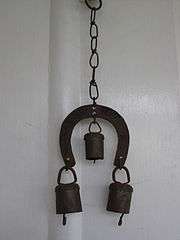Iron in folklore
Iron has a long and varied tradition in the mythology and folklore of the world.
In Europe
Cold iron
Cold iron is a poetic term for iron.
Francis Grose's 1811 Dictionary of the Vulgar Tongue defines cold iron as "A sword, or any other weapon for cutting or stabbing." This usage often appears as "cold steel" in modern parlance.
Rudyard Kipling's poem "Cold Iron", found in his 1910 collection of stories Rewards and Fairies, used the term poetically to mean "weapon".
"Cold iron" is historically believed to repel, contain, or harm ghosts, fairies, witches, and other malevolent supernatural creatures. This belief continued into later superstitions in a number of forms:
- Nailing an iron horseshoe to a door was said to repel evil spirits or later, to bring good luck.
- Surrounding a cemetery with an iron fence was thought to contain the souls of the dead.
- Burying an iron knife under the entrance to one's home was alleged to keep witches from entering.
In his novel Redgauntlet, the Scottish author Sir Walter Scott wrote, "Your wife's a witch, man; you should nail a horse-shoe on your chamber-door."
In modern fantasy, cold iron may refer to a special type of metal, such as meteoric iron or unworked metal. Weapons and implements made from cold iron are often granted special efficacy against creatures such as fairies and spirits.

Horseshoes

Horseshoes are considered a good luck charm in many cultures, including those of England, Denmark,[1] Lithuania, and Estonia, and its shape, fabrication, placement and manner of sourcing are all important. A common tradition is that if a horseshoe is hung on a door with the two ends pointing up (as shown here) then good luck will occur. However, if the two ends point downwards then bad luck will occur. Traditions do differ on this point, though. In some cultures, the horseshoe is hung points down (so the luck pours onto you); in others, it is hung points up (so the luck does not fall out); still in others it does not matter so long as the horseshoe has been used (not new), was found (not purchased), and can be touched. In all traditions, luck is contained in the shoe and can pour out through the ends.
In some traditions, any good or bad luck achieved will only occur to the owner of the horseshoe, not the person who hangs it up. Therefore, if the horseshoe was stolen, borrowed or even just found then the owner, not the person who found or stole the horseshoe will get any good or bad luck. Other traditions require that the horseshoe be found to be effective.

One reputed origin of the tradition of lucky horseshoes is the story of Saint Dunstan and the Devil. Dunstan, who would become the Archbishop of Canterbury in AD 959, was a blacksmith by trade. The story relates that he once nailed a horseshoe to the Devil's hoof when he was asked to reshoe the Devil's horse. This caused the Devil great pain, and Dunstan only agreed to remove the shoe and release the Devil after the Devil promised never to enter a place where a horseshoe is hung over the door.[2]
Another theory concerning the placing of horseshoes above doorways is to ward off Faeries; the theory being that supernatural beings are repelled by iron and as horseshoes were an easily available source of iron, they could be nailed above a door to prevent any unwanted, otherworldly guests.
Meteoric iron in Tibet
Thogcha (Tibetan: ཐོག་ལྕགས, Wylie: thog lcags )[3] means 'sky-iron' in Tibetan. Meteoric iron was highly prized throughout the Himalayas where it was included in sophisticated polymetallic alloys for ritual implements such as the singing bowl (Jansen, 1992) and phurba (Müller-Ebeling, et al., 2002).
Beer (1999: p. 234) holds that:
Meteoric iron or "sky-iron" (Tib. gnam lcags) is the supreme substance for forging the physical representation of the vajra or other iron weapons, since it has already been tempered by the celestial gods in its passage across the heavens. The indivisibility of form and emptiness is a perfect metaphor for the image of a meteorite or "stone fallen from the sky", manifesting out of the voidness of space as a shooting star or fireball, and depositing a chunk of fused "sky iron" on the earth below. Many vajras held by deities as weapons are described as being forged from meteorite iron, and Tibet, with its high altitude, thin atmosphere and desolate landscape, received an abundance of meteorite fragments. Tibetan vajras were often cast from meteorite iron, and as an act of sympathetic magic a piece of the meteoric iron was often returned to its original site.— [4]
See also
References
- ↑ Thorpe, Benjamin (1851). Northern Mythology: Comprising the Principal Popular Traditions and Superstitions of Scandinavia, North Germany, and the Netherlands. E. Lumley.
- ↑ Edward G. Flight (1871). The True Legend of St. Dunstan and the Devil: Showing How the Horse-Shoe Came to Be a Charm Against Witchcraft (Third ed.). London.
- ↑ Bellezza, John Vincent (March, 1999). Thogchags: The Ancient Amulets of Tibet. Source: (accessed: Wednesday April 14, 2010)
- ↑ Beer, Robert (1999). The Encyclopedia of Tibetan Symbols and Motifs (Hardcover). Shambhala. ISBN 1-57062-416-X, ISBN 978-1-57062-416-2. Source: (accessed: Thursday April 15, 2010), p.234.
Further reading
- Finneran, Niall (2003). Ethiopian evil eye belief and the magical symbolism of iron working. Source: http://findarticles.com/p/articles/mi_m2386/is_3_114/ai_n6118470 (accessed: Thursday, March 15, 2007)
- Lawlor, Robert (1991). Voices of the First Day: Awakening in the Aboriginal Dreamtime. Rochester, Vermont: Inner Traditions International, Ltd. ISBN 0-89281-355-5
- Jansen, Eva Rudy (1992). Singing bowls: a practical handbook of instruction and use. Holland: Binkey Kok Publications. (Refer partial scanning of book on following metalinkage (accessed: 1 December 2006) .)
- Müller-Ebeling, Claudia and Christian Rätsch and Surendra Bahadur Shahi (2002). Shamanism and Tantra in the Himalayas. Transl. by Annabel Lee. Rochester, Vt.: Inner Traditions.
- Bealer, Alex W. (1995). The Art of Blacksmithing. Edison, NJ: Castle Books. pp. 41–42. ISBN 978-0-7858-0395-9.
- Kosmerl, Frank (December 2001). Pennsylvania's goosewing axes and early iron and steel technology. Chronicle of the Early American Industries Association, Inc., The.
- Briggs, Robin. Witches & Neighbours: The Social and Cultural Context of European Witchcraft. Bury St. Edmunds, Suffolk: HarperCollins Publishers. 1996. ISBN 0-00-215844-2.
- Elworthy, Frederick Thomas. The Evil Eye: An Account of This Ancient and Widespread Superstition. New York: Bell Publishing Company. 1989. ISBN 0-517-67944-2. Reprint of the 1895 original.
- Guiley, Rosemary Ellen. The Encyclopedia of Witches and Witchcraft. New York: Facts On File, 1989. ISBN 978-0-8160-2268-7.
- Lawrence, Robert Means, M.D. The Magic of the Horseshoe with Other Folk-Lore Notes. Boston and New York: Houghton, Mifflin, and Company, 1898.